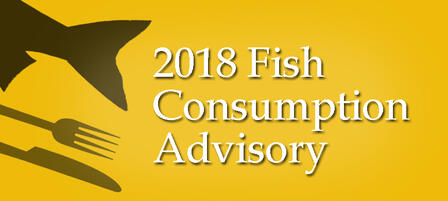2018 Kansas Fish Consumption Advisories

TOPEKA – The Kansas Department of Health and Environment (KDHE) and the Kansas Department of Wildlife, Parks and Tourism are issuing revised fish consumption advisories for 2018. The advisories identify types of fish or other aquatic animals that should be eaten in limited quantities or, in some cases, avoided altogether because of contamination. General advice and Internet resources are also provided to aid the public in making informed decisions regarding the benefits as well as the risks associated with eating locally-caught fish from Kansas waters.
Definitions
Bottom-feeding fish: buffalo, carp, carpsucker, catfish (except blue and flathead catfish), sturgeon, and sucker.
Predatory fish: black bass, blue catfish, crappie, drum, flathead catfish, perch, sunfish, white bass, wiper, striper, walleye, saugeye, and sauger.
Shellfish: mussels, clams, and crayfish.
General Population: Men and women 18 years of age or older.
Sensitive Populations: Women who are pregnant, may become pregnant, or are nursing and children age 17 or younger.
Meal size (skinless fish fillets before cooking):
Adults and Children age 13 and older = 8 ounces
Children age 6 to 12 = 4 ounces
Children younger than 6 = 2 ounces
Statewide Advisories
Kansas recommends the following consumption restrictions because of mercury in fish:
1. Sensitive Populations should restrict consumption of all types of locally-caught fish, from waters or species of fish not specifically covered by an advisory to one meal per week because of mercury.
2. Largemouth, smallmouth, and spotted bass (black basses):
A. Sensitive Populations should restrict consumption of these species to one meal per month because of mercury.
B. General Public should restrict consumption of these species to one meal per week because of mercury.
Existing advisories modified for 2018
Kansas has modified fish consumption advisories for portions of Cow Creek, the Kansas River, and Little Arkansas River because of decreased levels of polychlorinated biphenyls (PCBs) in bottom-feeding fish fillet samples collected in recent years.
Kansas recommends restricting consumption of bottom-feeding fish to one meal per week from the following location because of PCBs:
- Cow Creek in Hutchinson and downstream to the confluence with the Arkansas River (Reno County);
- The Kansas River from Lawrence (below Bowersock Dam) downstream to Eudora at the confluence of the Wakarusa River (Douglas and Leavenworth counties);
- The Little Arkansas River from the Main Street Bridge immediately west of Valley Center to the confluence with the Arkansas River in Wichita (Sedgwick County).
NEW advisories for 2018
K-96 Lake in Wichita (Sedgwick County) – Kansas recommends restricting consumption of bottom-feeding fish to one meal per month because of PCBs.
Arkalon Park Lakes in Liberal (Seward County) – Kansas recommends not eating fish or other aquatic life because the lakes are sustained solely by treated municipal wastewater.
Waterbody specific advisories for all consumers
Kansas recommends not eating specified fish or aquatic life from the following locations:
- The Arkansas River from the Lincoln Street dam in Wichita downstream to the confluence with Cowskin Creek near Belle Plaine (Sedgwick and Sumner counties); bottom-feeding fish because of PCBs.
- Shoal Creek from the Missouri/Kansas border to Empire Lake (Cherokee County); shellfish because of lead and cadmium.
- The Spring River from the confluence of Center Creek to the Kansas/Oklahoma border (Cherokee County); shellfish because of lead and cadmium.
- Antioch Park Lake South in Antioch Park, Overland Park (Johnson County); all fish because of the pesticides dieldrin, heptachlor epoxide, chlordane, and dichlorophenyltrichloroethanes (DDTs).
General advice for eating locally-caught fish in Kansas
- Sensitive populations should consider restricting their total mercury intake for both supermarket fish and locally-caught species. Concerned parents and other persons may wish to consult with a physician about eating fish and mercury exposure.
- Mercury exposure can be reduced by limiting the consumption of large predatory fish. Larger/older fish of all types are more likely to have higher concentrations of mercury.
- Avoid the consumption of fish parts other than fillets, especially when eating bottom-feeding fish. Fatty internal organs tend to accumulate higher levels of fat-soluble contaminants such as chlordane and PCBs than fillets.
- Consumers can reduce their ingestion of fat-soluble contaminants such as chlordane and PCBs by trimming fat from fillets, and cooking in a manner in which fat drips away from the fillet.
- Avoid subsistence level (relying on wild-caught fish for daily nutritional needs) fishing activities in large rivers within or immediately downstream of large urban/industrial areas and wastewater outfalls. Fish in these areas are more likely to contain traces of chemical contaminants.
- Kansas recommends not eating fish or aquatic life from surface waters sustained solely by municipal or industrial wastewater because of unknown, yet potentially present pathogens, metals, organic chemicals or other emerging contaminants. This advisory includes consumption of any aquatic life present in wastewater outfalls, waste treatment lagoons or stormwater detention ponds.
- In waterbodies where watches or warnings related to harmful algae blooms have been applied, fish should be consumed in moderation and care taken to only consume skinless fillets. Avoid cutting into internal organs and rinse fillets with clean water prior to cooking or freezing.
To view the advisories online and for information about KDHE’s Fish Tissue Contaminant Monitoring Program, visit www.kdheks.gov/befs/fish_tissue_monitoring.htm
-30-







